Schenkelhernie



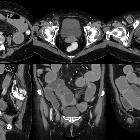





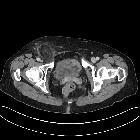




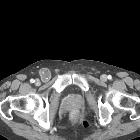
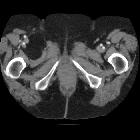

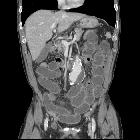
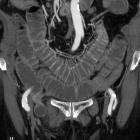
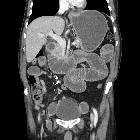
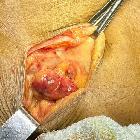

 nicht verwechseln mit: Obturatorhernie
nicht verwechseln mit: ObturatorhernieFemoral hernias (alternative plural: herniae) are a type of groin herniation and comprise a protrusion of a peritoneal sac through the femoral ring into the femoral canal, posterior and inferior to the inguinal ligament. The sac may contain preperitoneal fat, omentum, small bowel, or other structures.
Epidemiology
There may be an increased right-sided predilection . There is an increased prevalence in females .
Pathology
Most femoral hernias protrude inferior to the course of the inferior epigastric vessels and medial to the common femoral vein. They often have a narrow funnel-shaped neck and may compress the femoral vein, causing engorgement of distal collateral veins.
Occasionally, a femoral hernia may develop differently or be located somewhere besides medially to the femoral vessels. Possibilities include a hernia developing through the lacunar ligament (Laugier's hernia), or through the pectineal fascia (Cloquet's hernia) . Femoral hernias in an atypical relation to the femoral vessels include those lateral (Hesselbach's hernia), prevascular (Velpeau's hernia) or retrovascular (Serafini's hernia) .
Radiographic features
Ultrasound
Scanning below the inguinal ligament, assessing the space medial to the femoral vein for a hernia. The Valsalva maneuver can be performed to provoke herniation; the common femoral vein should also dilate .
CT
Femoral hernias typically have a characteristic funnel-shaped neck.
On axial CT images, the neck of the femoral hernia sac may be seen as a narrow protrusion through the femoral ring just medial to the common femoral vein. This can often look indented and compressed by the hernia sac.
Coronal images can also be very useful and it is usually seen in the space containing the fat pad between the inguinal ligament, common femoral vein and adductor longus muscle . Assessment of compression of the femoral vein and any distal engorgement should be made.
Differential diagnosis
The main differential is made with inguinal hernias. Femoral hernias are more common in women and unlike inguinal hernias, they remain lateral to the pubic tubercle. Femoral hernias invariably compress the femoral vein, while it is rare for an inguinal hernia to compress the femoral vein.
See also
- abdominal hernias
- pantaloon hernia
- De Garengeot hernia: femoral hernia containing an appendix
Siehe auch:
- Bursa iliopectinea
- Schenkelhernie mit Appendix vermiformis
- inkarzerierte Schenkelhernie
- Ligamentum inguinale
- Typen femoraler Hernien
- Hernien der Leistenregion
- Obturatorhernie
- laterale Schenkelhernie
und weiter:

 Assoziationen und Differentialdiagnosen zu Schenkelhernie:
Assoziationen und Differentialdiagnosen zu Schenkelhernie:



